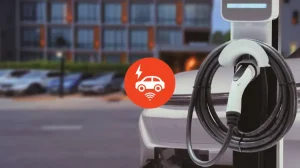The challenges of modern cities
More than 4 billion people live in cities worldwide, a number predicted to reach almost 7 billion by 2050. Cities are growing faster and faster, putting even more pressure on their infrastructure and, at the same time, on their governance to manage their scarce resources.

Fortunately, there is no need to wait for a solution, as today’s digital technologies have the potential to respond to the challenges of big cities, such as increasing congestion, noise, and air pollution. The key to sustainable urban development lies in smart city solutions that make cities’ use of resources smarter and more efficient, ensuring a prosperous and liveable future for their inhabitants.
This may raise the question of what we call a smart city (or otherwise an intelligent city) and what it means in practice to be a smart city. In the following paragraphs, we will clarify the concept of a smart city, its key areas and societal goals, and illustrate its functioning and positive benefits through the concrete example of smart parking.
Smart city as a concept and its social goals
It is important to note that there are many definitions and approaches, of which we have chosen one that captures the point in a comprehensive way: smart cities are cities that use information and communication technology to increase their operational efficiency, thus ensuring improved quality of government services and increased citizen welfare. In less scientific terms, smart cities use the innovative technologies available to create a better and more sustainable urban environment by connecting the different elements of urban infrastructure. One of the key elements of smart cities is data, which, if managed properly, can be used to run the city more cost-efficiently and provide a more liveable environment for its inhabitants. It is also important to point out that these cities do not look any different from the way they look now, but instead differ in the way they operate, as we will see through the example of smart parking.

The main objectives of a smart city are therefore to optimise urban functions, promote economic growth and improve the quality of life for citizens, while at the same time addressing sustainability issues. Key actors in smart city development include mayors and city officials who determine the role of smart innovations in the life of a city. Smart city solutions can make public services such as transport and public safety more cost-effective. So when city leaders see smart technologies as an innovative tool for sustainable urban development, citizens and the environment benefit.
Smart city as a concept and its social goals
It is important to note that there are many definitions and approaches, of which we have chosen one that captures the point in a comprehensive way: smart cities are cities that use information and communication technology to increase their operational efficiency, thus ensuring improved quality of government services and increased citizen welfare. In less scientific terms, smart cities use the innovative technologies available to create a better and more sustainable urban environment by connecting the different elements of urban infrastructure. One of the key elements of smart cities is data, which, if managed properly, can be used to run the city more cost-efficiently and provide a more liveable environment for its inhabitants. It is also important to point out that these cities do not look any different from the way they look now, but instead differ in the way they operate, as we will see through the example of smart parking.
The main objectives of a smart city are to optimize urban functions, foster economic growth and improve the quality of life for citizens, while at the same time addressing sustainability aspects. Key actors in smart city development include mayors and city officials who determine the role of smart innovations in the life of a city. Smart city solutions can make public services such as transport and public safety more cost-efficient. So, when city leaders see smart technologies as an innovative tool for sustainable urban development, citizens and the environment will benefit.
Smart city solution in practice: the case of smart parking
Typically, we distinguish between six subfields of smart city development: smart economy, smart mobility, smart living, smart people, smart governance and smart economy. An important element of smart mobility is smart parking, and we will now look at this area in more depth. Smart mobility solutions aim to develop and promote environmentally friendly, economical and time-saving alternatives. There are many such solutions, ranging from the creation of entirely new transport systems – take the example of self-driving cars – to the optimization of current ones, such as smart parking. But what problems does a smart parking system solve, how does it work in practice, and how do the smart city objectives listed above apply?
How smart parking works
Most drivers are probably familiar with the not exactly stress-free situation of driving around in circles for a long time looking for a parking space, only to end up finding a free space a long way away from their original destination. In the more congested areas of large cities, it is often almost impossible to find a free parking space, and the deployment of a smart parking system is one answer to this challenge by optimizing the use of parking spaces.
The smart parking system is based on parking sensors, which are flush mounted into the road surface of the parking spaces, without altering the urban landscape. The sensors detect whether cars are parked in the space and transmit this data to a central system. This information can be used for several purposes: on the one hand, drivers receive real-time information about the nearest available parking spaces, which can significantly reduce urban traffic by helping them to navigate to the available space without having to drive around looking for a free spot. If they find that there are no or very few spaces available, they may decide to choose another alternative, such as public transport.
Smart city goals and smart parking
In addition, the city administration will also benefit from a smart parking system by gaining data – such as the actual occupancy of parking spaces and therefore of public spaces – that was not available before. Armed with this data, they can make better and more informed decisions, optimize the efficiency of public space utilization, relieve pressure on infrastructure and thus increase the satisfaction of city residents.
Parking is a vital revenue stream for most cities, and smart parking can further increase this.
Among other things, it will improve and balance the use of parking spaces, optimize the routing of parking enforcement officers and allow targeted enforcement of parking violations by sending alerts. Such a system will also be able to distinguish between different types of parking spaces, be they electric charging stations, disabled spaces or loading bays. By monitoring the occupancy of loading bays, for example, loading periods can be revised based on real data to further maximize parking revenues.
These are just the direct economic benefits of smart parking, but looking a little further afield, there are also indirect benefits: smart parking also supports local businesses by providing easier access for stores, which increases their turnover, and can also generate additional revenue for cities by attracting new businesses.
As mentioned in the introduction, smart city solutions should not only serve economic purposes, but also enhance sustainability and quality of life. Smart parking also meets these criteria, as it reduces vehicle traffic, which in turn reduces air and noise pollution. The primary beneficiaries of cleaner air and a quieter environment are the more satisfied citizens.
Smart parking in Hungary
The good news is that smart parking is not a dream of the future, but very much a present that can be lived: we are already seeing such initiatives in Hungary. The biggest live system is already in operation in Budapest’s 5th district, where parking space occupancy data for the entire district is already available to drivers and city authorities. A pilot project is also running in Budapest’s 13th district around Szent István Park. Since the introduction of smart parking, parking operations have become more efficient, reducing carbon dioxide emissions and noise pollution, as well as saving hundreds of litres of fuel and a lot of time for motorists on a weekly basis.

These systems have already proven their reliability and have laid the first milestone on the road to becoming a smart city. Just think of the positive impact of more than 4,900 smart parking sensors, and the positive results that could be achieved if smart parking were to be introduced in most of the major cities.





